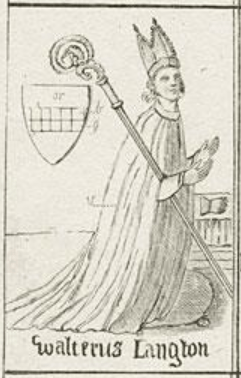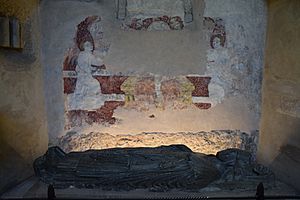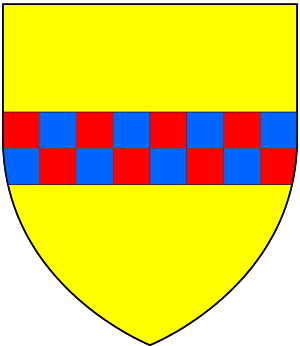Walter Langton facts for kids
Quick facts for kids Walter Langton |
|
|---|---|
| Bishop of Coventry and Lichfield | |

Walter Langton, 18th-century drawing of a now-lost stained-glass depiction in Lichfield Cathedral
|
|
| Elected | 20 February 1296 |
| Reign ended | 9 November 1321 |
| Predecessor | Roger de Meyland |
| Successor | Roger Northburgh |
| Orders | |
| Consecration | 23 December 1296 |
| Personal details | |
| Born | 2 September 1243 Leicestershire |
| Died | November 9, 1321 (aged 78) |
| Buried | Lichfield Cathedral |
| Denomination | Catholic |
Walter Langton (died 1321) was an important person in medieval England. He was the Bishop of Coventry and Lichfield and also served as the Lord High Treasurer for King Edward I. This meant he was in charge of the king's money. Langton helped improve and make Lichfield Cathedral more beautiful. His life was greatly shaped by his uncle, William Langton, and by his time working closely with King Edward I.
Contents
Who Was Walter Langton?
Walter Langton was born in Leicestershire, England. His family came from a place called "Langton." He was the oldest son of Simon Peverel. Walter decided to use "de Langton" as his last name. He was not related to another important person of his time, John Langton, who was the Bishop of Chichester.
Where Did Walter Langton's Family Come From?
The "Langton" area is an old parish with five smaller estates, including Thorpe Langton. While people traditionally thought Walter was born in West Langton, he later owned land in Thorpe Langton.
Walter Langton's Career
Walter Langton started his career in the church. He may have begun his training at a young age, possibly under the guidance of his uncle, William Langton, who was a high-ranking church official.
Working for King Edward I
Walter Langton became a trusted helper to King Edward I of England. He was appointed as the Keeper of the wardrobe from 1290 to 1295, which was an important role in the royal household. He also traveled to France for diplomatic missions.
In 1295, he became the Lord High Treasurer, managing the king's finances. He held this important job until 1307. On February 20, 1296, he was chosen to be the Bishop of Lichfield. As bishop, he rebuilt Eccleshall Castle, making it much grander.
Walter Langton faced some challenges, including accusations that were later found to be untrue. He had to go to Rome to defend himself. King Edward I strongly supported him, and Walter was eventually cleared of all charges. This shows how much the king trusted him.
He also had disagreements with the Prince of Wales, who later became Edward II of England. Despite these issues, King Edward I always stood by Langton. Walter Langton became the king's main advisor and was even chosen to carry out the king's will after his death.
After King Edward I Died
When King Edward I died in 1307, Walter Langton's situation changed. The new king, Edward II, and Langton's enemy, Piers Gaveston, quickly had him arrested. He was removed from his job and put in prison in places like London and Windsor. His lands and wealth were taken.
Even though important people like Pope Clement V tried to help him, Langton remained in prison. He was finally released in January 1312 and became treasurer again. However, some powerful nobles did not like him. He was later removed from the royal council in 1315.
Death and Burial
Walter Langton died on November 9, 1321. He was buried in Lichfield Cathedral, a place he had done so much to improve. His nephew, Edmund Peverel, inherited his lands.
Walter Langton's Properties
Besides his family lands in Leicestershire, Walter Langton owned other estates, including Castle Ashby in Northamptonshire. He got Castle Ashby in 1306 and was given permission by the king to build a castle there, which is why it's called "Castle Ashby" today. He passed these estates on to his brother and then to his nephew.
Building Projects at Lichfield
Walter Langton was known for his many building projects, especially at Lichfield Cathedral. People called him "another founder of this church" because of all he did.
Here are some of his contributions:
- He cleaned the area around the cathedral and built a stone wall around it.
- He built the cloisters (covered walkways) and spent a lot of money on a monument for St. Chad.
- He started building St. Mary's chapel in the cathedral, which was very beautiful. He left money in his will to finish it.
- He built bridges over the Minster pool, making it easier to get to the city.
- He helped improve the income and privileges of the Vicars Choral (church singers).
- He gave his old palace to the Vicars Choral and built a grand new episcopal palace for himself. This new palace had a huge hall, 100 feet long, decorated with paintings about King Edward I.
- He gave the church many valuable silver items and special robes.
- He built a beautiful gate at the west entrance to the Close (the area around the cathedral). Sadly, this gate was torn down in 1800.
- He also built or made bigger several castles and manor houses, including Eccleshall Castle and a palace in London.



